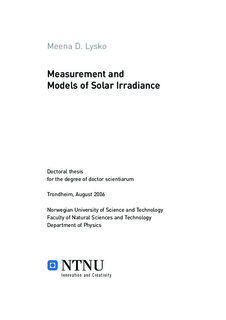| dc.description.abstract | Solar radiation is the main driving force for the Earth’s weather and climate. It is also the prime source for renewable energy technologies.Solar energy technologies can satisfy the current energy demand and at the same time reduce anthropogenic greenhouse gas emissions. It follows from scientific and engineering research within the field that accurate terrestrial solar radiation data and derived models can improve the detection of longterm climate change, the validation of Earth radiation budget estimates, and the deployment of solar energy systems. But, accurate assessment of solar energy at the Earth’s surface is difficult due to spatial, temporal and angular variability. These variations emphasise the need for localised solar radiation measurements and models.
In light of the above, this work has aimed at improving the quality of radiation data at two specific locations; one in Trondheim, Norway and the other in Durban, South Africa. This has entailed the development of an automatic data logging system, and frequent radiometer calibrations with traceability to the World Radiometric Reference. In addition, a radiometer called the Direct-Diffuse Solar Radiometer has been developed for the mapping of sky radiance. Supplementary work has been done to re-affirm the need for quality ground-based data.
The work done is twofold, the first on the measurements of solar irradiance and the second on the implementation of solar radiation models. So, the presentation of the work is divided into two parts. Chapters 1 to 5 are included in Part A under the heading “Measurement of Solar Irradiance”. Chapters 6 is given in Part B, “Data Modelling”.
Chapter 1 describes the concept of solar irradiance, discusses the components of solar radiation and introduces the radiometers in common use for the measurements of solar irradiance. Motivations for the development of the Direct-Diffuse Solar Radiometer are also included.
Chapter 2 describes the radiation mapping at the two sites, with particular emphasis on methods implemented for higher accuracy sampling, data reliability and continuity.
Regular radiometer calibration is necessary to ensure the data quality. Therefore the methodology for and results from calibration of the site radiometers are given in Chapter 3.
The acquired direct and global data for the sites are presented in Chapter 4. Diurnal 1-minute variations are discussed along with estimates of monthly and annual trends, with particular emphasis on atmospheric transmittance and the clearness index.
The last chapter in Part A, i.e. Chapter 5, presents the work done on the Direct-Diffuse Solar Radiometer (DDSR-1B). The instrument is designed for measuring sky irradiance as well as direct solar irradiance. The DDSR-1B is a prototype ground based instrument which is mounted on a remotely controlled solar tracker/sky positioner. The Chapter discusses the DDSR- 1B’s design, control, calibration and field tests in detail.
Chapter 6 in Part B considers 2 available software products that can generate estimates of direct normal solar irradiances for any ground location. This chapter also concludes the work for this thesis by reemphasising the need for localised solar radiation measurements and models.
Finally, Chapter 7 collects the major conclusions given through the course of this text. | nb_NO |
